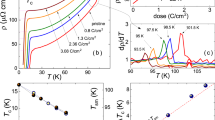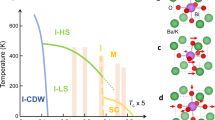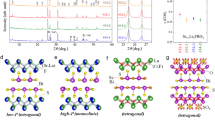Abstract
The nature of the superconducting pairing mechanism in the high-temperature superconducting oxides is still an open question. Shortly after the discovery of these materials, several groups began an intensive study of the oxygen isotope effect. For a monatomic conventional (BCS) superconductor, the transition temperature Tc is proportional to M–α, where M is the mass of the atom and α=0.5, assuming no anharmonicity for the phonon modes and no Coulomb interactions. For a multicomponent material, with an αi, defined for each ion with mass Mi. Thus, each element contributes to the overall α (which would still equal 0.5) with a weight dependent on the structure of the phonon modes that are important for superconductivity. Because the 16O/18O mass ratio is much smaller than the available mass ratios for the isotopes of the other atoms in these materials, the oxygen contribution to α (αox) should be the largest and thus in principle the easiest to measure. A zero or very small oxygen isotope effect would thus imply an unconventional pairing mechanism, although the suppression of in normal phonon-mediated superconductors is common. A large value of α (>0.3) indicates conventional (BCS) superconductivity. Ba1–xKxBiO3 was recently found to be superconducting1, with Tc ≈30 K. Unlike the planar cuprate supercon-dors, this material is cubic. Here we report on the 18O isotope effect for Ba0.625K0.375BiO3. We find that this material has a large isotope effect, indicating that the pairing mechanism is conventional (phonon-mediated).
This is a preview of subscription content, access via your institution
Access options
Subscribe to this journal
Receive 51 print issues and online access
$199.00 per year
only $3.90 per issue
Buy this article
- Purchase on Springer Link
- Instant access to full article PDF
Prices may be subject to local taxes which are calculated during checkout
Similar content being viewed by others
References
Cava, R. J. et al. Nature 322, 814–816 (1988).
Batlogg, B. et al. Phys. Rev. Lett. 59, 912–918 (1987).
Feltens, T. A. et al. Phys. Rev. Lett. 59, 915–918 (1987).
Zur Loye, H.-C. et al. Science 238, 1558–1560 (1987).
Bourne, L. C. et al. Phys. Rev. Lett. 58, 2337–2339 (1987).
Batlogg, B. et al. Phys. Rev. Lett. 58, 2333–2336 (1987).
Leary, K. J. et al. Phys. Rev. Lett. 59, 1236–1239 (1987).
Morris, D. E., Kuroda, R. M., Markelz, A. G., Nickel, J. H. & Wei, J. Y. T. Phys. Rev. B37, 5936–5939 (1988).
Katayama-Yoshida, H. et al. J. appl. Phys. Japan 26, L2085–L2086 (1987).
Marsiglio, F., Akis, R. & Carbotte, J. P. Solid St. Commun. 64, 905–910 (1987).
Hinks, D. G. et al. Nature 333, 836–838 (1988).
Hinks, D. G. et al. Physica C (in the press).
Mattheiss, L. F. & Hamann, D. R. Phys. Rev. Lett. 60, 2681–2684 (1988).
Garland, J. W. Jr, Phys Rev. Lett. 11, 114–119 (1963).
Author information
Authors and Affiliations
Rights and permissions
About this article
Cite this article
Hinks, D., Richards, D., Dabrowski, B. et al. The oxygen isotope effect in Ba0.625K0.375BiO3. Nature 335, 419–421 (1988). https://doi.org/10.1038/335419a0
Received:
Accepted:
Issue Date:
DOI: https://doi.org/10.1038/335419a0
This article is cited by
-
Superconductivity in (Ba,K)SbO3
Nature Materials (2022)
-
Valence-skipping and quasi-two-dimensionality of superconductivity in a van der Waals insulator
Nature Communications (2022)
-
Possible pairing mechanism switching driven by structural symmetry breaking in BiS2-based layered superconductors
Scientific Reports (2021)
-
Analysis of the superconductivity in perovskite oxides using three-square-well BCS formalism
Pramana (2015)
-
Thermodynamic properties of the superconductorsBaPb 0.7 Bi 0.3 O 3 andBa 0.7 K 0.3 BiO 3 using Eliashberg theory
Journal of Low Temperature Physics (1996)
Comments
By submitting a comment you agree to abide by our Terms and Community Guidelines. If you find something abusive or that does not comply with our terms or guidelines please flag it as inappropriate.



